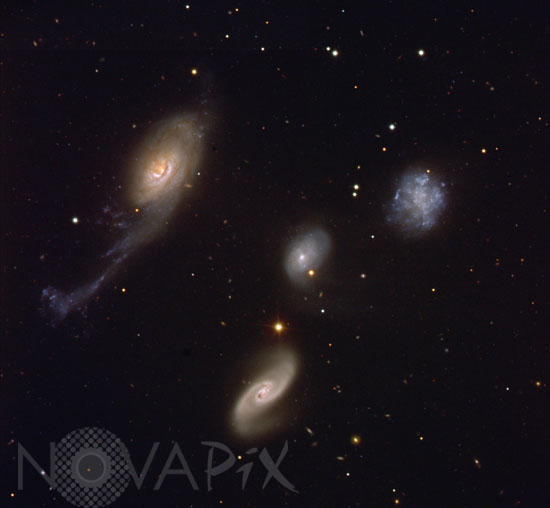Photo Agency - Astronomy - Space - Nature

Robert's Quartet interacting galaxies
author: ESO/Novapix
reference: a-amg02-00300
Image Size 300 DPI: 15 * 14 cm
Robert's Quartet is a family of four very different galaxies, located at a distance of about 160 million light-years, close to the centre of the southern constellation of the Phoenix. Its members are NGC 87, NGC 88, NGC 89 and NGC 92, discovered by John Herschel in the 1830s. NGC 87 (upper right) is an irregular galaxy similar to the satellites of our Milky Way, the Magellanic Clouds. NGC 88 (centre) is a spiral galaxy with an external diffuse envelope, most probably composed of gas. NGC 89 (lower middle) is another spiral galaxy with two large spiral arms. The largest member of the system, NGC 92 (left), is a spiral Sa galaxy with an unusual appearance. One of its arms, about 100,000 light-years long, has been distorted by interactions and contains a large quantity of dust. The quartet is one of the finest examples of compact groups of galaxies. Because such groups contain four to eight galaxies in a very small region, they are excellent laboratories for the study of galaxy interactions and their effects, in particular on the formation of stars. Using another set of VLT data also obtained with FORS2, astronomers were able to study the properties of regions of active star formation ("HII regions") in the sister members of Robert's Quartet. They found more than 200 of such regions in NGC 92, with a size between 500 and 1,500 light-years . For NGC 87, they detected 56 HII regions, while the two other galaxies appear to have far fewer of them. For NGC 88, however, they found two plume-like features, while NGC 89 presents a ring of enhanced stellar activity. The system is thus clearly showing increased star formation activity, most probably as the result of the interaction between its members. The quartet has a total visual magnitude of almost 13, i.e. it is about 600 times fainter than the faintest object that can be seen with the unaided eye. The brightest member of the group has a magnitude of about 14. On the sky, the four galaxies are all within a circle of radius of 1.6 arcmin, corresponding to about 75,000 light-years. Image obtained with the FORS2 multi-mode instrument on ESO's Very Large Telescope on October 30, 1999
Contact : Stéphane Aubin +33-(0)9-51-26-53-76
© Novapix - All rights reserved


